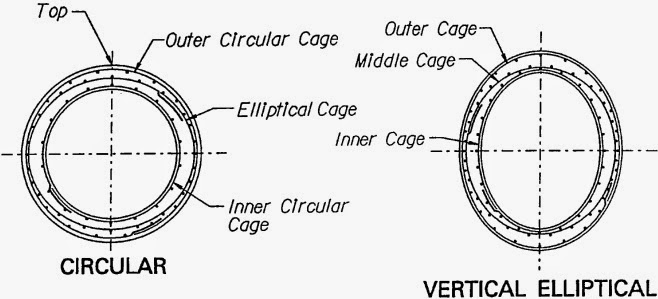CULVERT ( Gorong-Gorong )
Culvert is a structure that allows water to flow
under a road, railroad, trail, or similar obstruction. Typically embedded so as
to be surrounded by soil, a culvert may be made from a pipe, reinforced
concrete or other
material. A structure that carries water above land is known as an aqueduct.
Culverts
may be used to form a bridge-like structure to carry traffic. Culverts come in
many sizes and shapes including round, elliptical, flat-bottomed, pear-shaped,
and box-like constructions
Culverts
have three distinct uses. One is to control and direct drainage of accumulated
storm water runoff from crowned roads and side ditches. Another use is to
provide stream crossings for all three road types. The third and least
recognized use is to allow for natural movement of surface water on wet sites
where fill roads would otherwise adversely affect natural flow and alter the
hydrology of the area. This section covers the first and third uses. Another
section will cover water crossings.
Where possible, install culverts in natural draws on
all roads. If this is not convenient or if the culverts would be too far apart,
follow the broad-based dip spacing guidelines in Table bellow :
|
Table 1: Recommended spacing for water turnouts, culverts or
broad-based dips on wet soils.
|
|
|
Road Grade
|
Spacing Between Dips
|
|
2
|
300
|
|
3
|
235
|
|
4
|
200
|
|
5
|
180
|
Culverts - all other structures.
- Even though the costs of culverts are less than those of bridges, there are many times more culverts than bridges, and the total investment of public funds for culverts constitutes a substantial share of highway dollars.
- Culverts are usually designed to operate with the inlet submerged if conditions permit. This allows for a hydraulic advantage by increased discharge capacity. Bridges are usually designed for non-submergence during the design flood event, and often incorporate some freeboard.
- Culvert maintenance requirements include efforts to assure clear and open conduits, protection against corrosion and abrasion, repair and protection against local and general scour, and structural distress repair.
Besides that, culverts is also has
some type :
1. Pipe Arch Single or Multiple
Pipe-arch
culverts provide low clearance, openings suitable for large waterways, and are
more aesthetic. They may also provide a greater hydraulic advantage to fishes
at low flows and require less road fill.
2. Box
Culvert Single or Multiple
Box
culverts are used to transmit water during brief runoff periods. Theses are
usually used by wildlife because they remain dry most of the year. They can
have an artificial floor such as concrete. Box culverts generally provide more
room for wildlife passage than large pipe culverts. Box culvertsare usually
made up of Reinforced Concrete (RCC)
3. Arch Culvert
A pipe
arch culvert is a round culvert reshaped to allow a lower profile while
maintaining flow characteristics. It is good for installations with shallow
cover.
Material Of
Culverts
There is some material that used to
build Culverts :
ü concrete
(reinforced and non-reinforced)
ü
steel (smooth and corrugted)
ü
corrugated aluminum
ü
vitrified clay
ü
plastic
ü
bituminous fiber
ü
cast iron
ü
wood
ü stainless
steel
Two or
more materials may be combined to form composite structures. For example,
open-bottom corrugated steel structures are often built on concrete footings. Plastic
culvert liners are also inserted into failing concrete or steel structures in
order to repair the structure without excavating and closing the road. To
prevent the older structure from collapsing, the space between it and the
plastic liner is usually filled with grout.
Culvert End
Treatments
end structures are attached to end
of culvert barrel to reduce erosion, inhibit seepage, retain the fill, and
improve hydraulic characteristics.
Possible Choices:
·
Projecting
·
Mitered
·
Flared-end Section
·
Headwalls and Wingwalls







0 komentar:
Posting Komentar